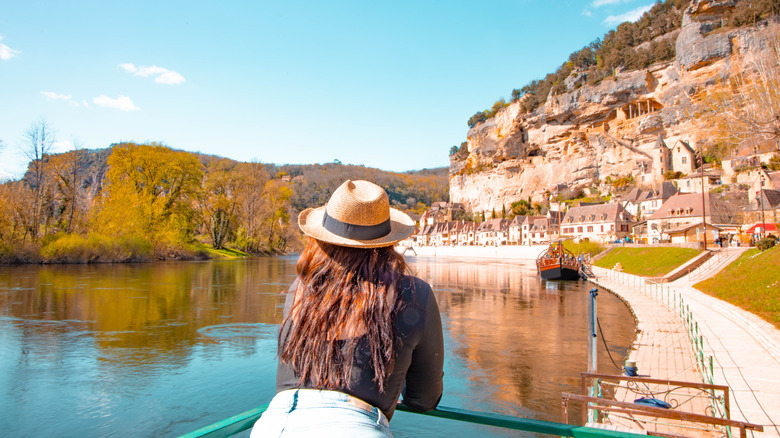This Charming River Valley Is One Of France's Cutest Regions, According To Rick Steves
France welcomes nearly 100 million visitors each year, making it one of Europe's most exciting places to explore. And yet, while most travelers stick to the usual tourist spots, few venture into the regions that feel like they've been pulled straight from the pages of a storybook. One of the most magical of these is the Dordogne River Valley. Winding gently through southwest France for 300 miles, the Dordogne is not only among the ten longest rivers in the country — it's also one of the cleanest. In fact, it holds the rare distinction of being the first river in the world to be named a UNESCO Biosphere Reserve from its source all the way to the sea.
This often overlooked region is among France's most underrated tourist destinations. Known as the "cradle of mankind," and "Land of 1001 Caves," the Dordogne is home to prehistoric cave art, cliffside castles, golden-stone towns, medieval villages, and some of the country's most beloved culinary traditions — including farms that produce some of France's best strawberries, goat cheese, walnuts, and foie gras. It's no wonder Rick Steves writes on his website, "Once you experience it, you'll wonder why more Americans don't visit." And he's right. With its unspoiled beauty and deeply rooted traditions, the Dordogne River Valley isn't just a detour — it's a destination, where charming towns that look like they're from a fairytale are simply part of everyday life. Rick Steves isn't the only one captivated by the Dordogne's beauty. Villages like Beynac-et-Cazenac, La Roque-Gageac, and Domme are all officially listed among Les Plus Beaux Villages de France — a national title recognizing France's most beautiful places.
Things to do in the Dordogne
According to Rick Steves, "Two of the most picturesque are La Roque-Gageac, a strong contender for "cutest town in France," and Beynac, a well-preserved medieval village that winds like a sepia-tone film set from the river to the castle above." And it's hard to disagree when you see ochre-colored homes between the cliff and the riverbank. He recalls paddling along the river, pulling ashore in Beynac, and climbing to a cliff-top castle, where he bought a ticket from the noble lady he described as "land rich but, apparently, cash poor." His stories — funny, specific, and vivid — don't just capture the charm of the Dordogne; they make a strong case for why it deserves a top spot on your travel list.
The best way to explore is not by car but by canoe. "When I'm here, one of my rituals is exploring the riverside castles and villages via canoe," Rick Steves recommends. And he's right — gliding along the river gives you a front-row seat to some of France's most enchanting countryside. You should also consider visiting Sarlat-la-Canéda, as the weekly market spills over with veggies, truffles, cheese, and berries so sweet, locals can guess the month by taste, according to Rick's description on his website.
Don't miss La Roque St-Christophe, a cliffside shelter inhabited for 55,000 years — a stunning blend of history, nature, and everyday wonder. But the true must-see lies deeper underground. Lascaux, home to one of the world's most famous prehistoric paintings, dated to around 15,000 years ago, was closed to protect the artwork — but it was meticulously recreated using the same techniques, bringing the past to life with hundreds of animal figures. Rick Steves explains, "Descriptions of the caves' impressiveness sound like overstatement until you see them in person."
Getting to the Dordogne, where to stay, and the best time to visit
Most international travelers begin their Dordogne adventure by flying into Bordeaux–Mérignac Airport, the closest major hub. From there, it's a two to 2.5-hour drive into the heart of the valley. Expect to spend roughly $14 to $55, depending on your mode of transport — whether by bus, train, or car. Aéroport Brive Vallée de la Dordogne (to the east) and Aéroport Bergerac Dordogne Périgord (just under 4 miles from Bergerac) are both small, convenient airports that land you close to many of the region's most popular sights. Flying into Toulouse is another option, though you'll need to factor in an extra two to three hours of driving to reach your final stop. Accommodations range from rustic farmhouses and riverside gîtes to boutique inns, grand châteaux, and cozy chambres d'hôtes — with many starting around $65 per night. You can also book a campsite, many of which are beautifully located near the river or nestled in peaceful corners of the countryside.
Spring and fall are the ideal times to visit the Dordogne Valley, according to Rick Steves on his website, with mild weather, beautiful colors, and fewer crowds. Summer, however, is the most popular time to visit, when the countryside is lush and nearly all attractions, restaurants, and markets are open. The weather is usually warm and pleasant, with temperatures ranging from 25° to 35°C. That said, travelers visit the Dordogne year-round — no matter the season. What matters most is packing the right essentials: sun protection, a good hat, a swimsuit, a light jacket, and waterproof shoes. Whether you're paddling beneath castle walls or sipping wine under walnut trees, the Dordogne is truly one of France's most amazing off-the-radar experiences.


